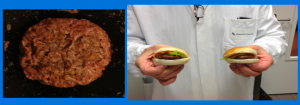 De tweede blog voor TEDxHaarlem gaat over kweekvlees. Mark Post vertelde hoe hij en zijn team uit stamcellen van spierweefsel een hamburger kunnen laten groeien. De spierstamcellen weten wat ze moeten worden, de onderzoekers hoeven alleen de juiste condities te creëren. Mark Post vertelde tijdens een pauze gisteravond dat het hamburgervlees nu goed genoeg is om te eten. Ik vond het fascinerend dat op deze manier misschien een mogelijkheid is gevonden om vleeseters te voeden zonder daarvoor de aarde geweld aan te doen, met een schoon geweten.
De tweede blog voor TEDxHaarlem gaat over kweekvlees. Mark Post vertelde hoe hij en zijn team uit stamcellen van spierweefsel een hamburger kunnen laten groeien. De spierstamcellen weten wat ze moeten worden, de onderzoekers hoeven alleen de juiste condities te creëren. Mark Post vertelde tijdens een pauze gisteravond dat het hamburgervlees nu goed genoeg is om te eten. Ik vond het fascinerend dat op deze manier misschien een mogelijkheid is gevonden om vleeseters te voeden zonder daarvoor de aarde geweld aan te doen, met een schoon geweten.
“Tissue engineering is the research area Mark Post is working on. He develops in vitro meat, meat made in a lab. He develops this for the food industry, as an alternative for the inefficient way in which cows and other livestock is producing meat. A hamburger of meat out of a lab, does it taste the same?
70 percent of our farmland around the world is used for keeping livestock. That is already the maximum. With all the mouths to feed in the future, the inefficient way livestock is producing meat won’t feed 9 billion people in 2050.
Mark Post is a physician and researcher of physiology. He creates blood vessels in a lab. “Are there any vegetarians here? You can doze off for a while, I’m going to speak to the meat lovers.” He states that the bioconversion rate of cows is just 15%. They belch methane, a greenhouse gas. Cows add 20% of that gas to our atmosphere. “A veggy with a Hummer is better for our planet than a meat eater with a bike.”
Winston Churchill, a friend of Nobel Prize winner Alexis Carrell, saw the possibilities of culturing meat in a lab. Carrell could keep organs alive outside of the body. Churchill said: “Fifty years hence, we shall escape the absurdity of growing a whole chicken in order to eat the breast or wing, by growing these parts separately under a suitable medium.”
And that’s what Mark Post does: growing meat in a petri dish.
A biopsy from a cow with muscle and fat stem cells (you need the fat for taste) can grow into a enormous amount of meat. One stem cell can make 10.000 kg meat. Muscle stem cells are good, they are waiting to repair muscle in your body. These cells are exercise junkies. In a cow they get their training from walking. We put Velcro strips in the petri dish and they use them as anchor points to grab onto. When grown into muscle fibre they start to contract.
A hamburger needs 60 billion cells. You need a bioreactor vat of 25.000 litre to grow meat for 40.000 people.
To make it meat, we have to mimic it for the right taste, colour and texture. So we colour it with a mixture of red beets and saffron. It takes about 7 to 8 weeks to grow muscle fibre. In the future you could do this at home. Order a strip of muscle fibre, put it into your incubator and in about two months time you can eat your hamburger.
The process is not very efficient yet. We still need to do much research on feeding the stem cells, how to feed them efficiently, which stem cells are the best to use.
And the final challenge is: will people eat it? It’s Frankensteinish. But picture this: two packages of meat in the supermarket. Onze labeled Eko-product and the text “An animal has suffered for this product”. On the other one a green label of sustainability. A hamburger made of cultured beef is maybe the answer to our greenhouse problems…”